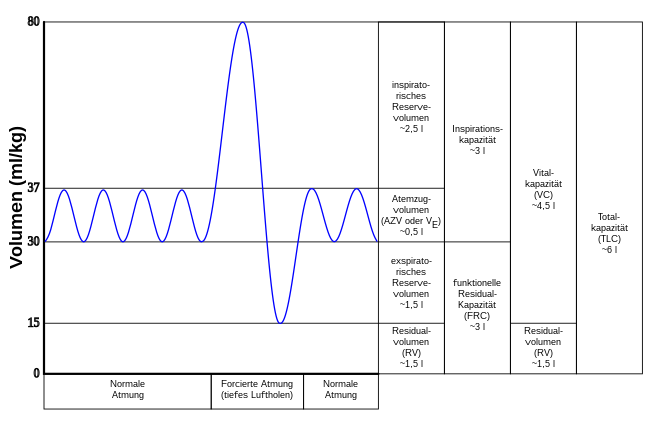Lung volume
Lung volumes (also respiratory gas volumes, tidal volumes, lung volumes) are various functional amounts of air in the lungs and airways that occur in the physiology of respiration . A person's individual values provide information about their lung function .
Definitions of terms and typical values in humans
The tidal volume is the amount of breath that is inhaled and exhaled (ventilated) per breath. It is around 0.5 liters when breathing at rest. Such averages relate to young adults weighing approximately 70-75 kg. Depending on the textbook, there are slightly different values. This also explains the different information in the diagram and in the following text.
The tidal volume can be expanded by a further 3 liters with voluntary ventilation, which makes the reserve volume (also supplementary air, reserve air) available to the lungs. 1.5 liters each are accounted for by the inspiratory and expiratory reserve volume . Together, breathing air and supplementary air provide a reserve of 3.5 liters, which a person can ventilate in one breath. This amount describes the vital capacity as the static volume . After maximum exhalation, 1.5 liters of air remain as residual volume in the airways and lungs. Vital capacity and residual volume together give the total capacity , ie the total lung volume that is in the lungs after a maximum inspiration.
The functional residual volume ( functional residual capacity ) describes the volume of air that remains in the lungs during normal breathing (sum of reserve volume and residual volume). The maximum amount that can be inhaled after exhaling a normal breath is the inspiratory capacity . It is the sum of the tidal volume and the inspiratory reserve volume.
The dead space is the part of the airways in which no gas exchange takes place, i.e. from the mouth / nose to the bronchioles. Its size in milliliters is roughly equivalent to body weight x2, i.e. 150 ml for a person weighing 75 kg.
The tidal volume is the volume of air that is inhaled and exhaled in a certain period of time. It is measured in l / min and is defined as the respiratory frequency multiplied by the tidal volume. At rest it is around 7.5 l / min. The breathing limit value (also minute limit value) is the breathable air volume that can be ventilated per minute at maximum tidal volume and maximum frequency. The breathing limit is usually 120 to 170 liters per minute.
Most lung volumes can be determined using a spirometer . However, a body plethysmograph is required to determine the residual volume and total lung capacity .
Variations between people and over a lifetime
The figures indicate the averages in adult humans. Some people have up to six liters of vital capacity. Competitive swimmers reach values of 8 liters, apnea divers like the world record holder Herbert Nitsch even up to 10 liters. Around the age of 20 people reach their maximum vital capacity V or VC. It is 3 to 4 liters and can drop to less than 2 liters with age.
The decrease in vital capacity with advancing age is due to a loss of elasticity in the lungs and restricted mobility of the thorax. The total capacity remains roughly constant, however, so there is an increase in the residual volume. The functional residual capacity is around 3.0 liters in young men and around 3.4 liters in older men. In women, the values are around 10–20% lower.
Formulas for vital capacity
As a guideline for an adult young man, depending on his height G in m, the following applies to VC in liters:
In women this value is about 25% lower:
According to another source, this applies roughly to young men
- , so for a man who is 1.70 m tall
For women, the values are 10–20% lower.
Individual evidence
- ↑ a b c Oliver Thews, Karl Kunzelmann: Ventilation and respiratory mechanics . In: Ralf Brandes, Florian Lang, Robert F. Schmidt (Hrsg.): Physiologie des Menschen . 32nd edition. Springer-Verlag GmbH Germany, Berlin 2019, ISBN 978-3-662-56467-7 , p. 331-333 .
- ↑ a b Armin Kurtz: Breathing . In: Hans-Christian Pape, Armin Kurtz, Stefan Silbernagel (eds.): Physiology . 7th edition. Georg Thieme Verlag KG, Stuttgart 2014, ISBN 978-3-13-796007-2 , p. 312-315 .
- ↑ Friedrich Naglschmid (Ed.): Diving training for CMAS * . 5th, revised. Edition. Delius Klasing, Bielefeld 2010, ISBN 978-3-7688-3173-4 .
- ↑ Descent into the water hell. In: Spiegel Spezial. 6/2007, November 6, 2007, p. 124.
swell
- Helmut Glück (Ed.): Metzler Lexicon Language. 2000.
- Paperback of Physiology. 1996.
- Peter Lotz: Anatomy and Physiology of the Respiratory Tract. In: J. Kilian, H. Benzer, FW Ahnefeld (ed.): Basic principles of ventilation. Springer, Berlin et al. 1991, ISBN 3-540-53078-9 , pp. 3-45. (2nd, unchanged edition, ibid 1994, ISBN 3-540-57904-4 )



![{\ displaystyle VC [l] = 7 \ cdot (G-1)}](https://wikimedia.org/api/rest_v1/media/math/render/svg/8e59441537f682411201590f013bc429a23ff42c)
![{\ displaystyle VC [l] = 7 \ cdot (1.7-1) = 4.9l}](https://wikimedia.org/api/rest_v1/media/math/render/svg/e1c49b91be3c83f4ab55c3a1ce4d7ce32491cde8)